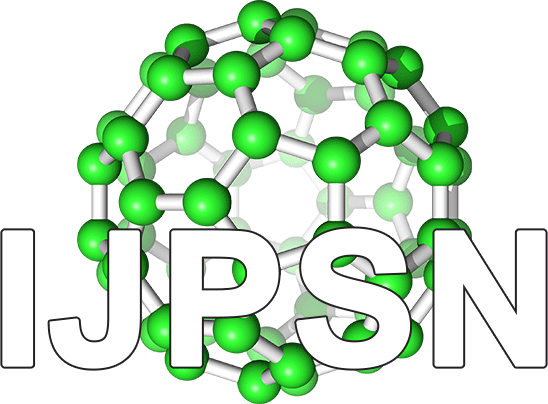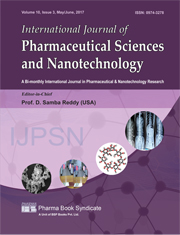Xyloglucan based Microspheres for Pulmonary Delivery of Rifabutin Dry Powder Inhaler
DOI:
https://doi.org/10.37285/ijpsn.2017.10.3.2Abstract
Pulmonary delivery of anti-tubercular drugs can be an effective treatment for tuberculosis. The main objective of the present work was to prepare rifabutin loaded xyloglucan microspheres as dry powder inhaler for pulmonary delivery. Xyloglucan is natural polysaccharide with mucoadhesive property and temperature responsive gelling ability allows its application in microspheres development. Xyloglucan microspheres were prepared by using single step spray drying process using lactose. All microsphere formulations were evaluated for various physical properties such as density and flow. On the basis of results of evaluation parameters such as entrapment efficiency, mucoadhesion, swelling and in vitro drug release, microspheres with 2% xyloglucan and 1% lactose monohydrate were found to be most favorable. They possessed morphology and particle size distribution suitable for pulmonary administration. XRD studies reveal amorphous nature of microspheres. In vitro DPI performance demonstrates suitability of xyloglucan based microspheres for pulmonary delivery. In conclusion, it is suggested that this natural polymer based microspheres containing rifabutin DPI formulation could be used as a significant enhanced treatment for TB.
Downloads
Metrics
Keywords:
Xyloglucan, Microspheres, Pulmonary delivery, Dry Powder InhalationDownloads
Published
How to Cite
Issue
Section
References
Berishvili TA (1954). PAS Inhalation therapy of respiratory tuberculosis in the sanatorium LIBANI; preliminary communication. Probl Tuberk 4: 69-70.
Byron PR (1986). Prediction of drug residence times in regions of the human respiratory tract following aerosol inhalation. J Pharm Sci 75: 433-438.
Chan HK (2006). Dry Powder Aerosol Delivery Systems: Current and Future Research Directions. J. of Aerosol Medicine, 19: 21-27.
Edwards DA, A. Ben-Jebria and R. Langer (1998). Recent advances in pulmonary drug delivery using large, porous inhaled particles. J Applied Physiology 85: 379-385.
Fu-De C, Y. Ming-Shi, Y. Ben-Gang, F. Yu-Ling, W. Liang and Y. Peng (2003). Preparation of sustained release nitrendipine microspheres with eudragit RS and aerosil using quasi-emulsion solvent diffusion method. Int J Pharm 259:103-113.
Glicksman M (Ed) (1986). Tamarind seed gum. In Food Hydrocolloids, CRC Press, Boca Raton, Florida. vol. III, 191-202.
Jain SA, DS. Chauk, H.S. Mahajan, A.R. Tekade and S.G. Gattani (2009). Formulation and evaluation of nasal mucoadhesive microspheres of sumatriptan succinate. J Micro 26: 711-721.
Jensen DM, D. Cun, M.J. Maltesen, S. Frokjaer, H.M. Nielsen and C. Foged (2010). Spray drying of siRNA-containing PLGA nanoparticles intended for inhalation. J. of Control Rel, 142: 138–145.
Juan JT, G.A. Alfredo, T.S. Santiago, G. Luis (2001). Spray-dried powders as nasal absorption enhancers of cyanocobalamin. Bio and Pharm Bull, 24: 1411-1416.
Kellaway IW, M. D. Abd Ei-Hameed (1997). Preparation and in vitro characterization of mucoadhesive polymeric microspheres as intra-nasal delivery systems. Eur J Pharm and Biopharm 44: 53-60.
Kinnarinen T, Labiris NR and M.B. Dolovich (2003). Pulmonary drug delivery. Part II: The role of inhalant delivery devices and drug formulations in therapeutic effectiveness of aerosolized medications. Bri J of Clin Pharmacol. 56: 600-612.
Ludwig B (2005). The use of mucoadhesive polymers in ocular drug delivery. Adv Drug Del Rev, 57: 1595-1639.
Muttil P, J. Kaur, K. Kumar, A. B. Yadav, R. Sharma and A. Misra (2007). Inhalable microparticles containing large payload of anti-tuberculosis drugs. Eur J Pharma Sci, 32: 140-150.
N.R. Labiris and M.B. Dolovich (2003). Pulmonary drug delivery. Part I: Physiological factors affecting therapeutic effectiveness of aerosolized medications. Brit J Clin Pharmacol 56: 588-599.
Nishinari K, Yamatoya K and Shirakawa M (2000). Xyloglucan. Handbook of Hydrocolloids, Wood head Publishing Limited Cambridge, 247-267.
O’Hara P and A. J. Hickey (2000). Respirable PLGA microspheres containing rifampicin for the treatment of tuberculosis: manufacture and characterization. Pharm Res, 17: 955-961.
Pandey R and G.K. Khuller (2005). Antitubercular inhaled therapy: opportunities progress and challenges. J Antimicro Chemotherapy 55: 430-439.
Panyam J and Labhasetwar V (2003). Biodegradable nanoparticles for drug and gene delivery to cells and tissue. Adv Drug Del Rev 55: 329-347.
Patton JS and P.R. Byron (2007). Inhaling medicines: delivering drugs to the body through the lungs. Nature Review on Drug Discovery 6: 67-74.
Saraparn H, L. Vimolmas, S. Narueporn and C.R. Garnpimol (2006). Spray-dried mucoadhesive microspheres: preparation and transport through nasal cell monolayer. AAPS Pharm. Sci. Tech. 7(1): E79-E88.
Shah N, M. kondawar, R. Shah and V. Shah (2011). Sustained release of spray- dried combination dry powder inhaler formulation for pulmonary delivery. Asian J of Pharm and Clin. Res 4: 112-118.
Shenoy DB and M. M. Amiji (2005). Poly (ethylene oxide)-modified poly (epsilon caprolactone) nanoparticles for targeted delivery of tamoxifen in breast cancer. Int J of Pharm 293: 261-270.
Shirakawa M, K. Yamotoya and K Nishinari (1998). Tailoring of xyloglucan properties using an enzyme. Food Hydrocolloid, 12: 25–28.
Suarez S, P. O’Hara, M. Kazantseva, C.E. Newcomer, R. Hopfer, D.N. McMurray and A.J. Hickey (2001). Respirable PLGA microspheres containing rifampicin for the treatment of tuberculosis: screening in an infectious disease model. Pharm. Res 18: 1315-1319.






